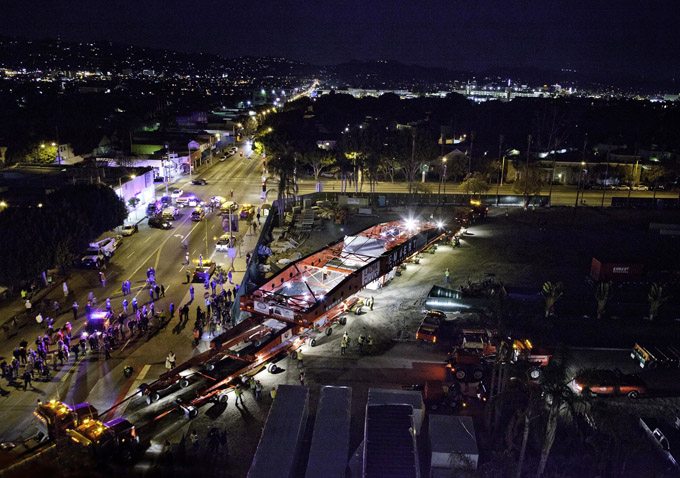 The new documentary from Doug Pray, “Levitated Mass,” is a story about an artist, a museum, a city, a piece of art. But what it’s really about is a rock. A rock that’s a star. Quite possibly one of the most famous rocks in the world, Levitated Mass, the massive monolithic land sculpture by land artist Michael Heizer that currently resides at the Los Angeles County Museum of Art. It’s a story of hope, inspiration, fellowship, and the definition of what art is to the many individuals that make up the public that experienced Levitated Mass in its journey to LACMA. The film is all of those things because of Doug Pray, who is an immensely talented documentarian (“Hype!”, “Scratch,” “Art & Copy,” and more), whose deft but unobtrusive direction makes the film so much more than just an advertisement for LACMA.
The new documentary from Doug Pray, “Levitated Mass,” is a story about an artist, a museum, a city, a piece of art. But what it’s really about is a rock. A rock that’s a star. Quite possibly one of the most famous rocks in the world, Levitated Mass, the massive monolithic land sculpture by land artist Michael Heizer that currently resides at the Los Angeles County Museum of Art. It’s a story of hope, inspiration, fellowship, and the definition of what art is to the many individuals that make up the public that experienced Levitated Mass in its journey to LACMA. The film is all of those things because of Doug Pray, who is an immensely talented documentarian (“Hype!”, “Scratch,” “Art & Copy,” and more), whose deft but unobtrusive direction makes the film so much more than just an advertisement for LACMA.
The story of Levitated Mass goes back to 1969, when conceptual art It Boy Michael Heizer was busily inventing “negative sculptures” and using the earth as his canvas. Not much became of the concept before he took to the Nevada desert to do his work in peace, but he let a Riverside, California quarry manager know “if you ever get a big rock…” and that’s where the film picks up, as a 340 ton, two-story rock is blasted out of the hillside, destined to become Art.
Once Heizer has claimed the stone, the wheels are set in motion with LACMA director and Heizer champion Michael Govan, who must round up the donations and team to get this rock from Riverside to L.A., and to engineer and build the trench atop which the mass will be levitated (visitors walk underneath). While Govan and the other museum directors are certainly extremely articulate in explaining the significance of Heizer and his work, it’s not until the drama of “how do we move this thing?” that the film really picks up. Pray excels at capturing character and place, knowing that the two are inextricable, and takes the time with so many of the people involved in making this art a reality, from the city bureaucrats to the quarry workers to the employees of Emmert, the company charged with hauling the thing.
If you were in Southern California in March of 2012, there’s a good chance you already know Levitated Mass, as the rock’s journey captured the attention of the region and turned its passage into a local sensation. The film (and the piece itself) is at its best when people are interacting with it, because the point of the sculpture is to change your perspective to your place on the earth, which it manages to do, even before it’s in place, when it’s strapped to a football field-sized tractor trailer. Communities of people pour out into the streets to see the rock, standing with their neighbors in their pajamas in the middle of the night, just to see it move. It’s as much a portrait of and love letter to Los Angeles and it’s surrounding cities as it is to the piece itself.
The local flavor is the best part of the film, and Pray knows this, as he allows for many different interviews with people of the 22 cities that the rock passed through, creating montages that are hilarious and insightful. He shoots the rock from inside businesses, bars and buildings, creating a human scale in the film. Ultimately, that’s what it’s about, the scale of this rock juxtaposed with the scale of the human. So even if Michael Heizer had no intention of the affect that this rock would have before it was properly in place, it was still effective rolling through the streets of Long Beach, Riverside, Chino, Carson, or South Central. People are drawn to the rock, in awe, or in disgust (it is a $10 million rock rolling through some pretty impoverished neighborhoods), whether it’s inspiration from the team of people who decided to work together and fight the obstacles get this done in the name of art, or religious fervor from an accidental parking spot (outside a church named Rock of Salvation, in Spanish).
While the film makes commentary about the nature of the art world, the role of the museum, and the commerce of art and objects, it ultimately begs the question: what is art? And while there are many answers posited in the film, what it ultimately comes down to is right in front of us—art would be nothing without people, spectators (and workers and visionaries and artists). Art needs people to thrive, and people need art for inspiration, entertainment, hope, or just to stand with their neighbors to experience “a thing.” The proximity, orientation, and monumental nature is what makes Levitated Mass the piece so powerful, and “Levitated Mass” the film not only captures that but puts those ideals forth as something culturally and socially important, something that happened when the mass met the masses. [B+]

